|
|
|
 |
Supported Programmer Control Methods |
|
|
The programmer supports the following control methods:
- Standalone Mode - Keypad and LCD controlled (no PC)
- Development Mode - Controlled via PC Software - Equinox Development Suite (EDS)
- Project Upload Mode - PC Controlled
- ISP-PRO - Production Software (chargeable upgrade)
- ASCII Text Communications Protocol (RS232 Serial control - chargeable upgrade)
|
 |
Target Interface Capabilities |
|
|
The FS2003 supports the following Target Interfaces / Algorithms:
- Atmel AVR - SPI - Serial Programming Mode
- Atmel AT89S - SPI - Serial Programming Mode
- Atmel ATtiny11/12/15 High-Voltage Serial Programming Mode
- UART Boot Loader - for Atmel T89C51Rx2 8051 microcontrollers
- UART Boot Loader - for Philips P89C51Rx2 and P89C66x 8051 microcontrollers
- Atmel ATmega JTAG In-System Programming (ISP) - chargeable upgrade
- 24Cxxx Serial EEPROMs I2C (Two-Wire Interface)
|
 |
Standalone Programming Mode |
|
|
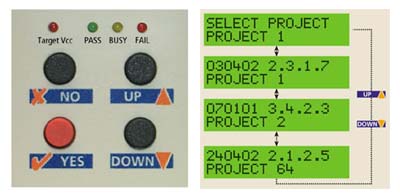
In ‘Standalone Mode’, the FS2003 is controlled via the push buttons on the front panel of the programmer - no PC connection is required. The programmer LCD and the LED Status Indicators are used to display the current status of the programmer. It is possible to select from 1 of 64 previously uploaded Programming Projects and then to repeatedly execute this project to program a batch of devices.
In Standalone Mode...
- Programmer is completely portable as no PC connection is required
- Programmer supports storage up to 64 independent Programming Projects in the non-volatile On-board 4Mbits FLASH Memory Store .
- The operator simply selects the required project using LCD and keypad
- Each project name is version controlled showing the project name, date, firmware revision and build date. e.g. myproject-240402-2.3.4.12
- Single key auto-program mode
- Simple PASS / FAIL response with diagnostics on program failure
- Operator can not inadvertently change the programming data or settings
To configure the programmer for Standalone Mode...
- A Project Collection containing 1 - 64 Programming Projects must be uploaded on a one-off basis to the programmer using the EQTools PC software
- This is a single file which can be easily distributed to remote sites. It contains all projects, Hex File data, Fuse information etc.
|
 |
Development Mode |
|
|
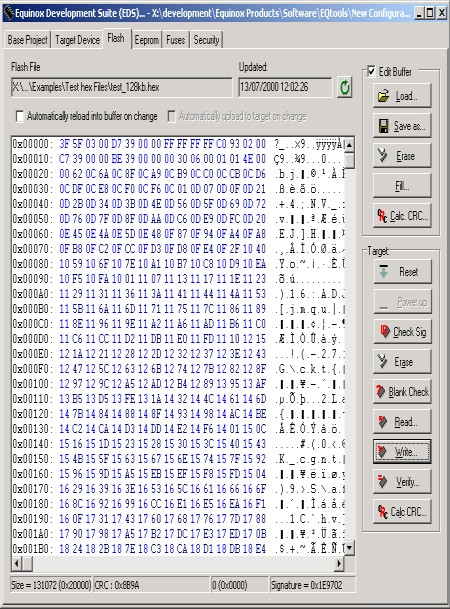
- Programmer is controlled from the PC via EQTools - Equinox Development Suite (EDS) Software
- Ideal for use in a Development Environment
- Supports manual writing / reading of FLASH / EEPROM memory areas
- Supports manual writing / reading of Fuses and Security Fuses
- All projects can be developed and tested on a real device before uploading a Programming Project to the programmer
- Tested Programming Projects can then be uploaded to the Programmer for use in Standalone Mode
|
 |
Project Upload Mode |
|
|
This mode allows a pre-compile Project Collection to be uploaded to the on-board 'FLASH Memory Store'.
The programmer can store up to 32 MBits of Project Information which is held indefinitely in non-volatile FLASH Memory.
It is possible to upload up to 64 Programming Projects to the programmer, each of which can be for a different target device.
A simple 'Upload Wizard' allows field personnel to upload single or multiple Programming Projects as part of Project Collections.
|
- This mode allows a pre-compile Project Collection to be uploaded to the on-board 'FLASH Memory Store'.
-
The programmer can store up to 32 MBits of Project Information which is held indefinitely in non-volatile FLASH Memory.
-
It is possible to upload up to 64 Programming Projects to the programmer, each of which can be for a different target device.
-
A simple 'Upload Wizard' allows field personnel to upload single or multiple Programming Projects as part of Project Collections.
|
 |
ISP Header Support |
|
|
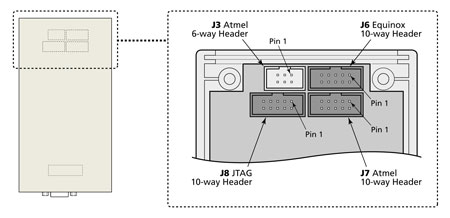
The FS2003 programmer features all the popular In Sytem Programming (ISP) Headers including:
- Atmel 10-way SPI Header (for Atmel AVR and AT89S microcontrollers)
- Equinox 10-way Header (for Atmel AVR and AT89S microcontrollers) and I2C Serial EEPROMs
- Atmel 6-way SPI Header (for Atmel AVR and AT89S microcontrollers)
- Atmel 10-way JTAG ISP Header (for JTAG ISP of Atmel ATmega AVR microcontrollers)
- Equinox 10-way UART Header (for Atmel AT89C51Rx2 and Philips P89C51RX2 and P89C66x microcontrollers)
This allows the programmer to interface directly to most target systems without requiring an external cable convertor.
Please refer to the ISP Header Overview page for full details of all available ISP Headers and ISP Cables.
|
 |
Programmer / Target System - Power Supply Options |
|
|
The Programmer supports the following powering options:
- Target System can supply power to the programmer: 3.0 - 5.0V @ 50mA
- Programmer can supply power to the Target System: 5.0V @ 300mA
- Programmer and Target System can be Independently Powered
The Programmer comes with a 9V DC Power Supply which is regulated down to +5.0V inside the programmer.
|
 |
JTAG ISP Support for Atmel ATmega AVR Microcontrollers |
|
|
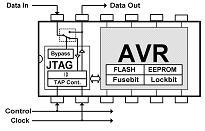
The FS2003 supports programming of the Atmel ATmega AVR Microcontroller Family using the JTAG algorithm. This chargeable upgrade allows the FS2003 to program the ATmega devices at high speed via the JTAG port of the Target Device.
The advantages of JTAG In-System Programming are:
- Much faster programming times (up to x4 times faster than SPI)
- JTAG port can also be used as a 'Debug Port' during product development
|
 |
Individually configurable Programmer I/O pins |
|
|
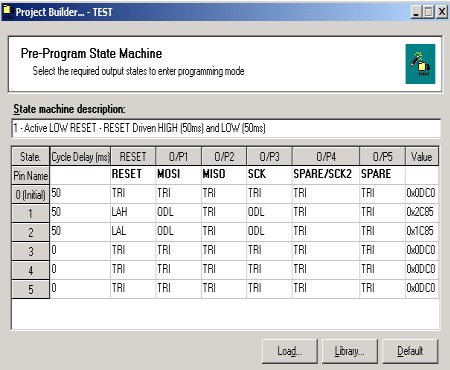
Each pin of the FS2003 programmer is individually user-configurable via the 'Pre-programming State Machine' to any of the following states:
- TRI - TRI-STATE
- LAH - Logic Active High
- LAL - Logic Active Low
- ODH - Output Driven High
- ODL - Output Driven Low
The 'Pre-programming State Machine' supports the following functionality:
- Reset drive can be configured to suit any RESET Circuit
- Complicated RESET circuits such as Watchodog Timer IC's, RESET Monitoring IC's etc. can be supported by altering the timings and I/O sequence.
- Sequencing of custom logic on the Target System in order to enter Serial Programming Mode
|
 |
Configurable Frequency Output Clock |
|
|
The FS2003 is capable of outputting a continuous square wave at various frequencies on the programmer SCK2 pin.
This clock frequncy could be used for the following purposes:
- To toggle the STROBE pin on a Watchdog Timer IC to stop the IC from timing out during the In-System Programming operation.
- To provide a clock to an Atmel ATmega microcontroller to resurrect a device which has an incorrectly configured Internal Oscillator.
|
 |
CE / FCC Approved Product |
|
|
The FS2003 is a CE and FCC approved product.
|
 |
Spare Programmer I/O pins |
|
- In SPI mode, there are 2 x Spare I/O pins for custom use
- In UART mode, there is 1 x Spare I/O pins for custom use
- The spare I/O pin(s) can be used for controlling circuitry on the user Target System including Chip Selects, additional RESET control lines, Watchdog Timers etc.
|
 |
Fast Programming Times |
|
|

The FS2003 supports fast programming of Target Devices via the SPI, JTAG and UART algorithms.
|
 |
Standalone Mode - Program -> Test -> Re-Program |
|
|
The programmer is capable of performing a multi-project Programming Sequence in Standalone Mode as follows:
- Program Test Firmware
- Execute Target Firmware
- Wait for Target Firmware to finish
- Program Production Firmware
This powerful functionality allows the programmer to be used as part of an In-Circuit Test procedure where the Target Firmware must be allowed to execute in order to eg. calculate some calibration values. The programmer initially programs some 'Test Firmware' into the Target Device and then allows the Target to run this firmware and waits for this firmware to finish executing. The real 'Production Firmware' is then programmed into the Target Device.
|
| |
This product has been discontinued. Please refer to the Replacement Product instead: